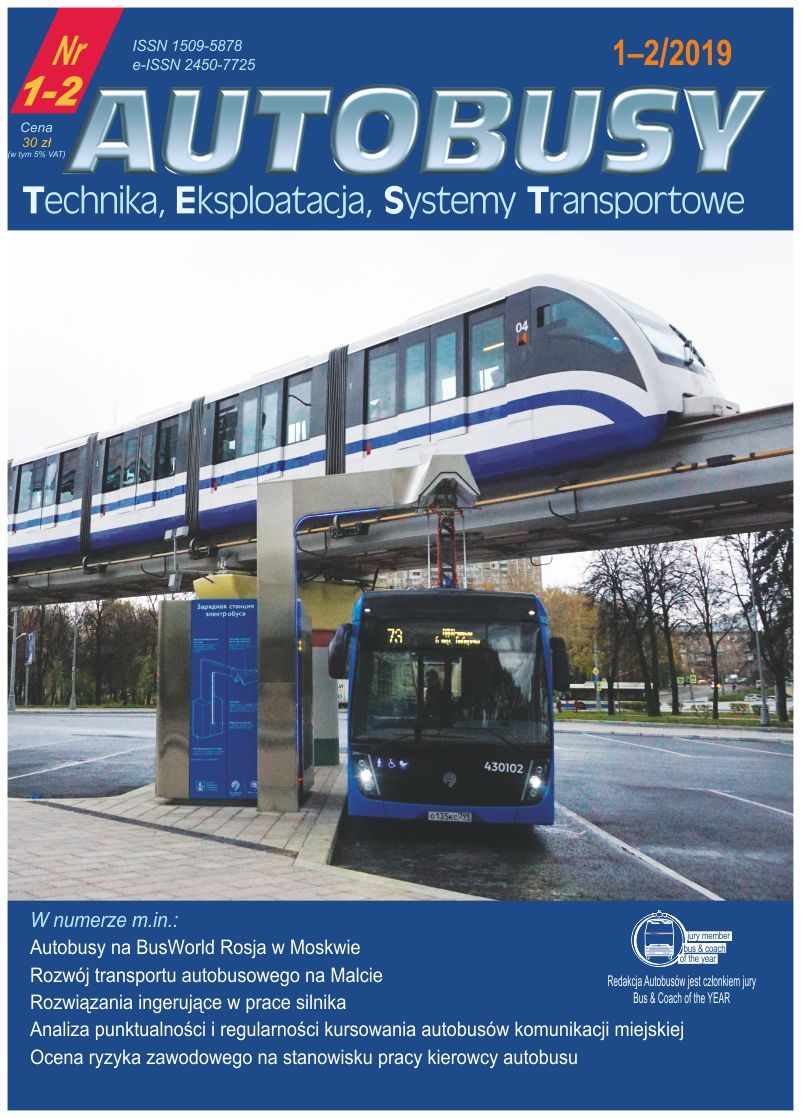Methods of extinguishing plastics used in the construction of means of public transport - factors affecting fire extinguishing efficiency
DOI:
https://doi.org/10.24136/atest.2019.018Keywords:
traffic safety, extinguishing systems, polymers, high-pressure water fog, aerosol genera-tors, fire extinguishersAbstract
The article analyzes the methods of extinguishing plastic materials, mainly polymer ones, occurring in the construction of means of public transport, ie. buses, trams, trains, metro etc. The characteristics of flammability and decomposition reactions were discussed and this was confronted with the characteristics of wood decomposition as an interchangeable material in extinguishing tests according to the Polish standard PN-EN 3-7 "Portable fire extinguishers - Part 7: Characteristics, performance requirements and test methods" due to the com-mon occurrence of these firefighting devices in both buses and other public transport. In addition, other methods of extinguishing means of public transport resulting from current trends, i.e. aerosol systems and water mist, have been indicated. The extinguishing methods were confronted, indicating their advantages, disadvantages and application possibilities in means of public transport, including buses..
Downloads
References
Barbagli M. "Theoretical and Practical Perspectives of Application of High Pressure Water Mist Systems for Railway Vehicles." Problemy Kolejnictwa 160, Warszawa 2013, s. 7-27.
Huiqing Zhang, Fire-safe polymers and polymer composites, Washington 2004.
Janowska G., Przygocki W., Włochowicz A., Palność polimerów i materiałów polimerowych, Warszawa 2007, 36-39.
Janowska G., Przygocki W., Włochowicz A., Palność polimerów i materiałów polimerowych, Warszawa 2007, 139-145.
Kiełbasa, T., Aerozole gaśnicze i ich generatory. Bezpieczeństwo i Technika Pożarnicza, Józefów 2010, s. 73-91.
Kulawik A, Machnicka-Hławiczka M,Mamos J,Steinhoff J., Recykling odpadów tworzyw sztucznych pochodzących ze zużytych samochodów, Główny Instytut Górnictwa w Katowicach. Publikacja opracowana w ramach projektu pt. „materiały polimerowe” 2010.
Łudzik A., Gaśnice: badania wybranych parametrów techniczno-użytkowych. Bezpieczeństwo i Technika Pożarnicza, Józefów 2010, 41-50.
Marciniak A. Analiza rozwiązań automatycznych systemów gaśniczych w pojazdach samochodowych, Autobusy 6/2018, Radom 2018.
Mizerski A., Sobolewski M., Grynczel Z., Środki gaśnicze: własności i zastosowanie, Arkady, Warszawa 1968.
PN-EN 3-7: 2004 + A1: 2008 Gaśnice przenośne -- Część 7: Charakterystyki, wymagania eksploatacyjne i metody badań.
Pofit-Szczepańska M., Wybrane zagadnienia z chemii ogólnej, fizykochemii spalania i rozwoju pożarów. SAPSP, Kraków 1994.
Porowski R., Wprowadzenie do analizy termicznej polimerów, Zeszyty Naukowe SGSP – Szkoła Główna Służby Pożarniczej, Warszawa 2017, Nr 64/4/2017.
Roguski J., Zbrożek P., Czerwienko D., Wybrane aspekty stosowania w obiektach budowlanych urządzeń gaśniczych na mgłę wodną, Józefów 2012.
Zbrożek, P., Generatory aerozoli gaśniczych wytwarzanych pirotechnicznie. Bezpieczeństwo i Technika Pożarnicza 2/4 Józefów 2006, s. 227-237.
https://ddtorun.pl/pl/15_fotorelacje/475_wypadki/3947_srodowy_pozar_autobusu_mzk_w_lubiczu.html (dostęp: 22.11.2018)
https://rosap.ntl.bts.gov/view/dot/12392 (dostęp: 22.11.2018)
http://czysteogrzewanie.pl/technika/spalanie-wegla-i-drewna-od-kuchni/ (dostęp: 24.11.2018)



